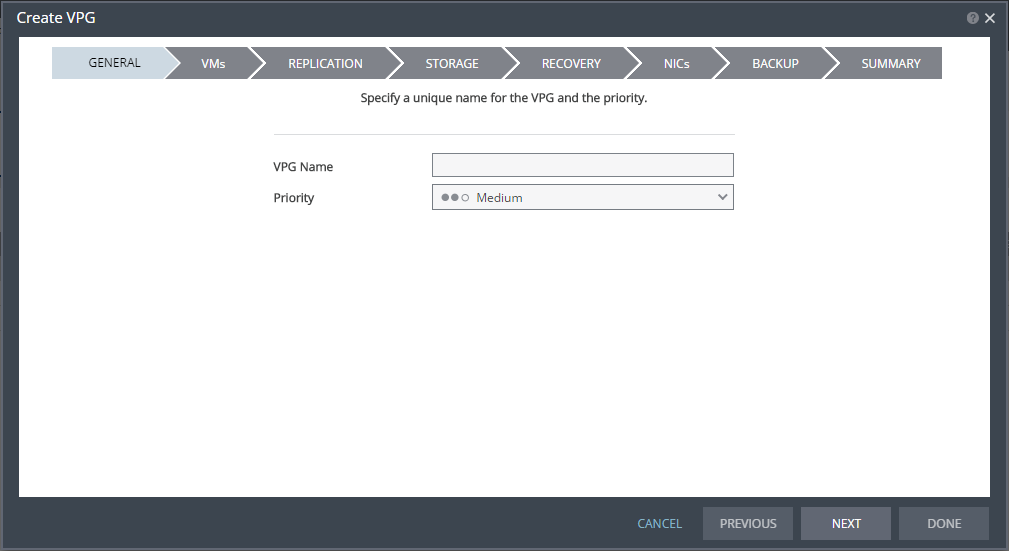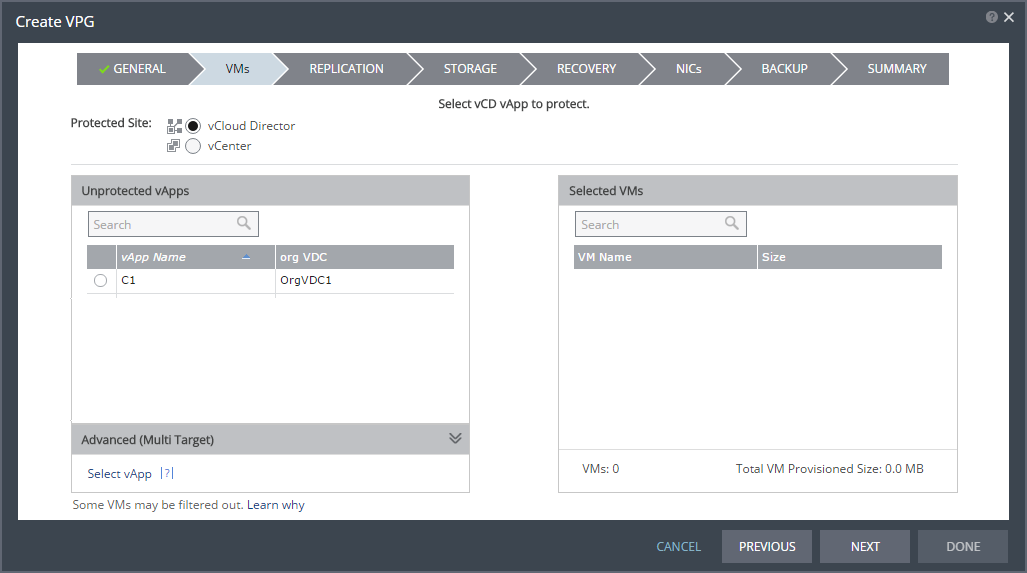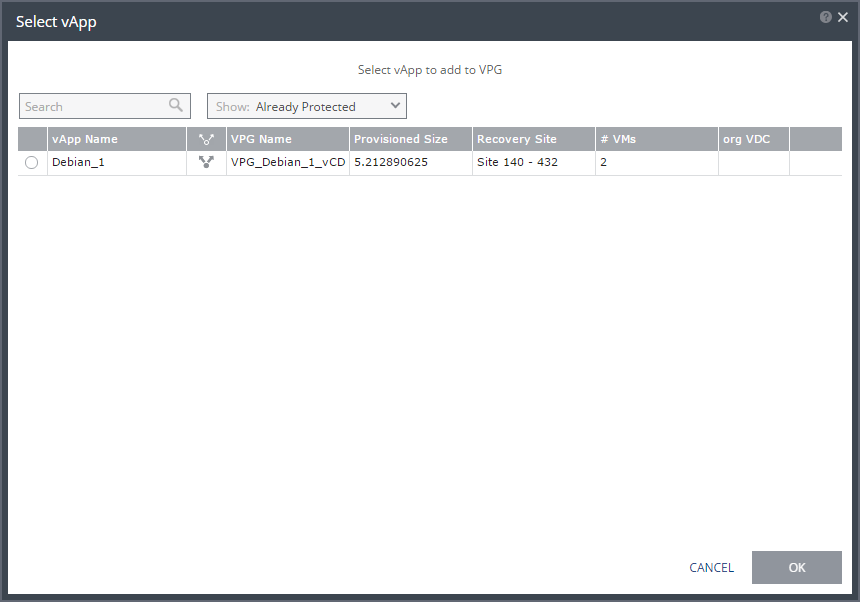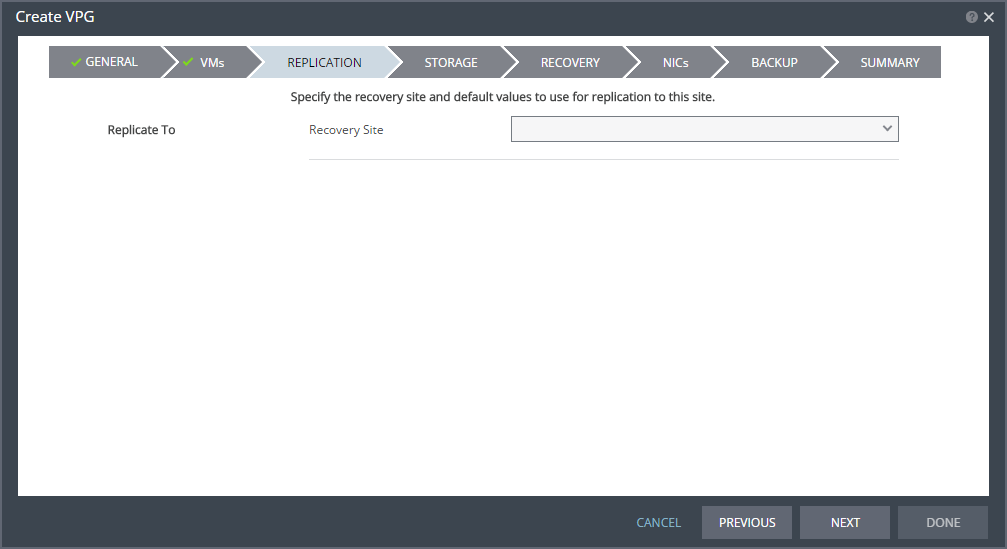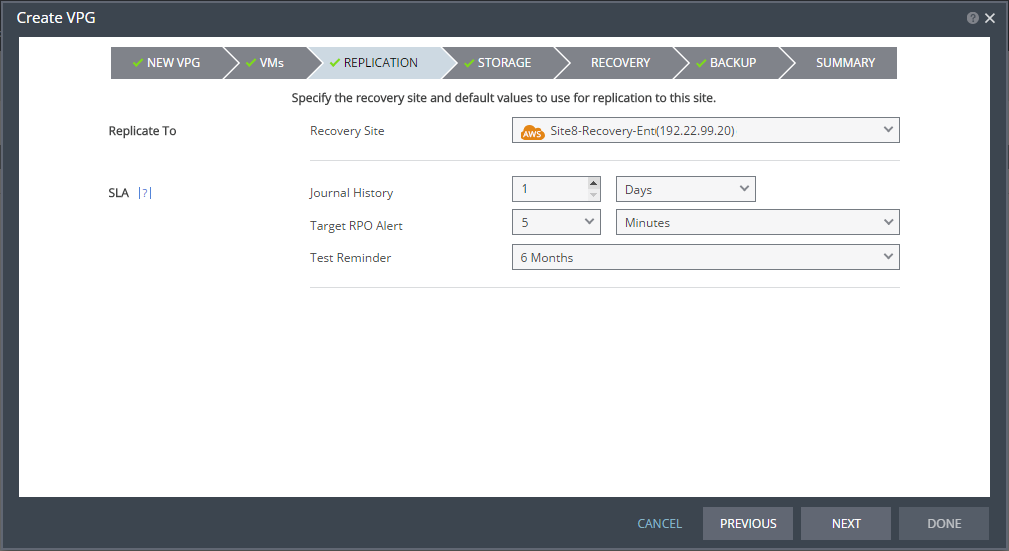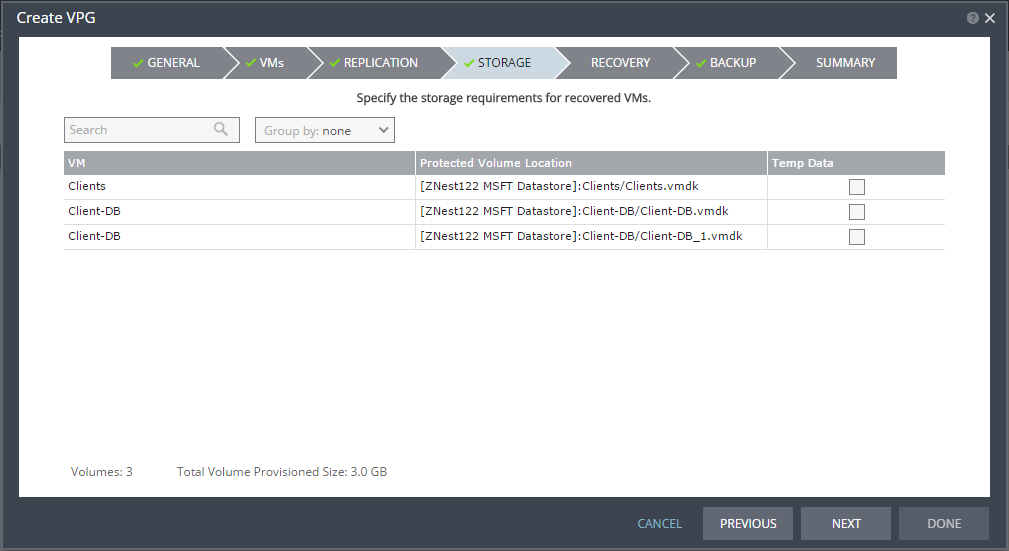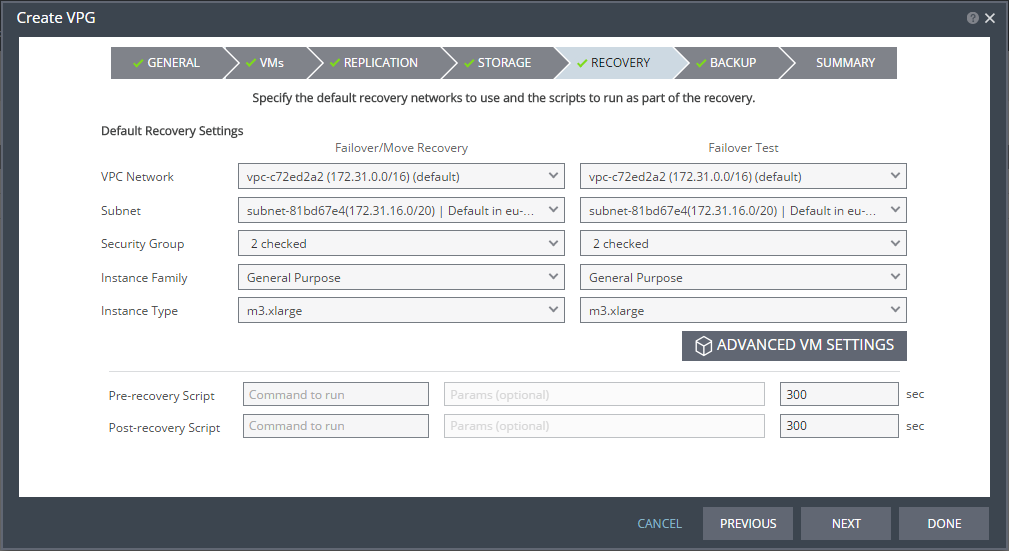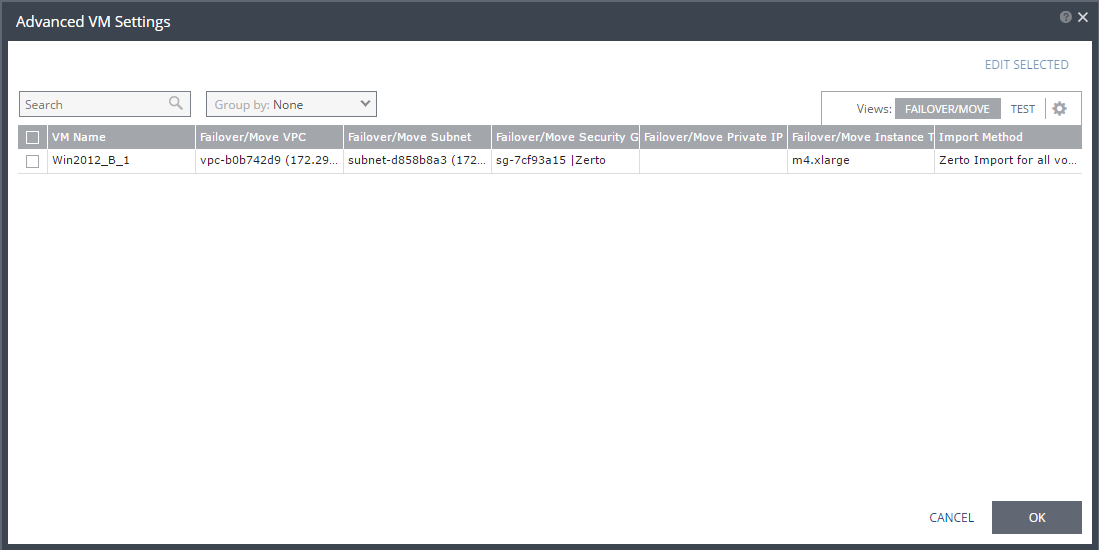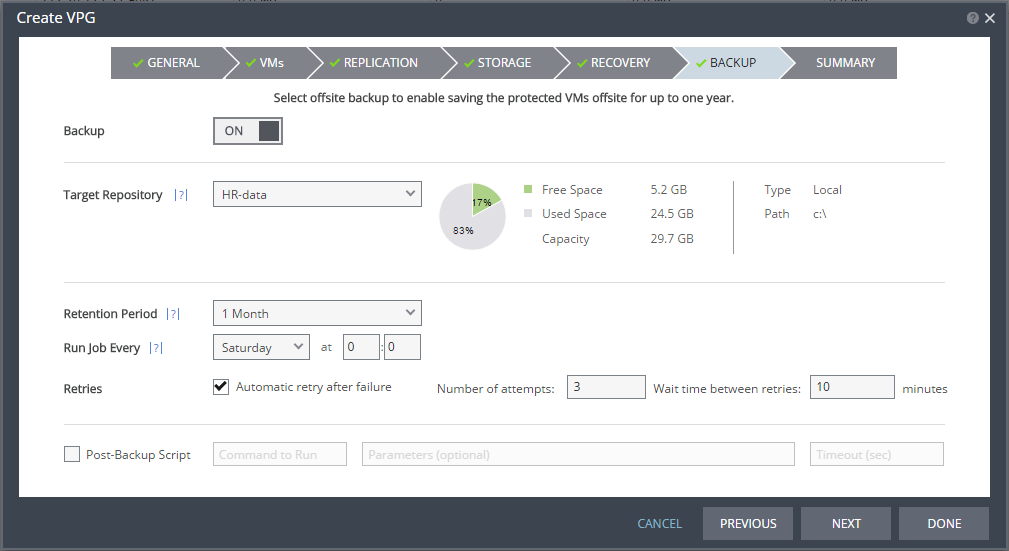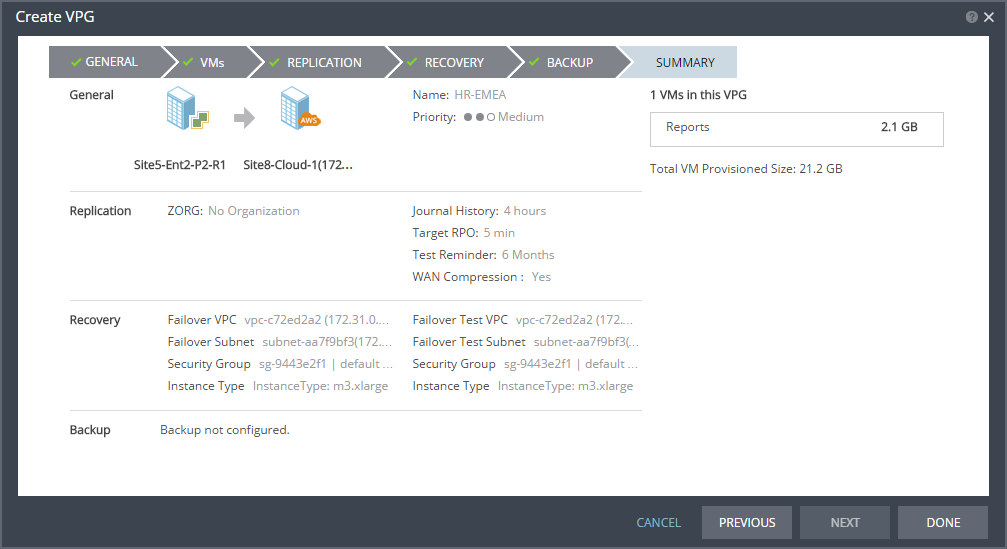Creating a VPG from vCloud Director to AWS
Use the following procedure to create a virtual protection group to protect to AWS.
To create a VPG from vCloud Director to AWS:
1. In the Zerto User Interface, select ACTIONS > CREATE VPG.
The GENERAL step of the Create VPG wizard is displayed.
2. Specify the name of the VPG and the priority of the VPG.
■ VPG Name: The VPG name must be unique. The name cannot be more than 80 characters.
■ Priority: Determine the priority for transferring data from the protected site to the recovery site when there is limited bandwidth and more than one VPG is defined on the protected site.
■ High Priority: When there are updates to virtual machines protected in VPGs with different priorities, updates from the VPG with the highest priority are passed over the WAN first.
■ Medium Priority: Medium priority VPGs will only be able to use whatever bandwidth is left after the high priority VPGs have used it.
■ Low Priority: Low priority VPGs will use whatever bandwidth is left after the medium priority VPGs have use it.
Updates to the protected virtual machines are always sent across the WAN before synchronization data, such as during a bitmap or delta sync.
During synchronization, data from the VPG with the highest priority is passed over the WAN before data from medium and low priority VPGs.
3. Click NEXT.
The VMs step is displayed.
You can select virtual machines to protect from the underlying vCenter Server or as a vCD vApp.
4. Select the vCD vApp to protect in this VPG.
■ When using the Search field, you can use the wildcards; * or ?.
■ Only vCD vApps that are unprotected are displayed in the list. A VPG can include:
■ Only one vApp.
■ vApps that are not yet protected.
■ vApps that are already protected.
5. To view protected vApps, in the Advanced (One-to-Many) section, click Select vApp.
The Select vApp window is displayed.
Note: With the One-to-Many feature, a VPG containing a single vApp can be recovered to a maximum of three different sites and cannot be recovered to the same site more than once.
vApps protected in the maximum number of VPGs are not displayed in the Select VMs window.
Protecting vApps in several VPGs is enabled only if both the protected and recovery sites, and the VRAs installed on these sites, are of version 5.0 and higher.
Note: Define the required boot order for vCD vApps in the vCloud Director console.
6. Click NEXT.
The REPLICATION step is displayed.
Note: If the protected site is paired with only one recovery site, the recovery step is displayed with the Recovery Site field automatically filled in and defaults set, as shown below.
7. Specify the recovery site.
■ Recovery Site: The site to which you want to recover the virtual machines. After specifying the recovery site, other fields are displayed.
Note: You cannot select a recovery site if any of the virtual machines you selected are already in VPGs that recover to that site.
8. ZORG: If the site is defined in Zerto Cloud Manager, select the name used by the cloud service provider (CSP) to identify you as a Zerto Organization (ZORG). For details about Zerto Cloud Manager, see Zerto Cloud Manager Administration Guide.
■ Service Profile: The name of the service profile to use which determines the VPG SLA settings for the group, which apply to every virtual machine in the group. To change the VPG SLA settings, select the Custom Service Profile.
9. If the VPG SLA settings are editable, when the Zerto Cloud Manager is not used or when a Custom service profile is available, specify these settings for the group, which apply to every virtual machine in the group.
■ Journal History: The time that all write commands are saved in the journal.
The longer the information is saved in the journal, the more space is required for each journal in the VPG.
Select the number of hours from 1 to 24 or the number of days from 2 to 30.
10. Target RPO Alert: The maximum desired time between each automatic checkpoint write to the journal before an alert is issued.
11. Test Reminder: The amount of time in months recommended between each test, where you test the integrity of the VPG. A warning is issued if a test is not performed within this time frame.
12. Click NEXT.
The STORAGE step is displayed.
By default the storage used for the virtual machine definition is also used for the virtual machine data.
For each virtual machine in the VPG, Zerto Virtual Replication displays its storage-related information.
13. Specify whether the protected volume is a temp data disk.
Temp Data: If the virtual machine to be replicated includes a temp data disk as part of its configuration, mark the recovery disk for this disk as a temp data disk. In this case, data is not replicated to the temp data disk after initial synchronization.
14. Click NEXT.
The RECOVERY step is displayed. Recovery details include the networks, security group, instance family, and instance type to use for failover, move, and testing failover, and whether scripts should run as part of the recovery process.
Note: Steps that do not require input are marked with a check mark. You can jump directly to a step that has been marked with a check mark to edit the values for that step. Every step must be marked with a check mark before you can click DONE to create the VPG.
15. Select recovery settings for failover/move and failover testing.
VPC Network: The virtual network dedicated to your AWS account. A security group and subnet must be assigned to this VPC.
Subnet: The subnet for the VPC network.
Depending on the import method selected, the list of subnets available for selection is shown.
Zerto Import - zImport: The subnet drop-down list shows the options available when either the Zerto Import for data volumes or the Zerto Import for all volumes is selected. Only the subnets that are supported by the zImport method are selectable. Other Subnets are grayed out and are not selectable.
Note: The zImport virtual machine must have access to the internet in order to access the S3 Bucket and the AMI in EC2. The only network in the customer environment that is certain to have internet access is the network that the ZCA is connected to. If the import method is not AWS Import, then the user can select only subnets that are part of the same Availability Zone as the one in which the ZCA resides. Other Subnets are disabled.
AWS Import: The Subnet drop-down list shows options available when AWS Import method is selected. All subnets are listed. A tool tip alert is displayed when the user hovers over a subnet that is not supported.
Note: If a subnet is chosen in a network that is not in the same Availability Zone as the one in which the ZCA resides, options that utilize the zImport method will not be made available for selection.
Security Group: The AWS security to be associated with the virtual machines in this VPG.
Instance Family: The instance family from which to select the type. AWS instance families are optimized for different types of applications. Choose the instance family appropriate for the application being protected in the VPG.
Instance Type: The instance type, within the instance family, to assign to recovered instances. Different types within an instance family vary, for example in vCPU, RAM, and local storage size. Choose the instance type appropriate for the application being protected in the VPG. The price per instance is related to the instance configuration.
16. For additional settings, click ADVANCED VM SETTINGS.
The Advanced VM Settings window is displayed, which shows the recovery network settings for FAILOVER/MOVE for virtual machines in the VPG. You can see the recovery network settings for failover tests by clicking TEST.
17. To edit information in one field, click the field and update the information.
18. To edit information for several virtual machines at the same time, select the virtual machines and click EDIT SELECTED.
The Edit VM Settings window is displayed.
19. Update the values for VPC network, subnet, security group, instance family, instance type, and private IP as necessary.
Note: Only private IPs specified for Windows machines are assigned during a recovery operation. For Linux machines, the IP is assigned from the specified subnet range.
Clearing the values in the Private IP field results in an IP being automatically assigned from the subnet range during a recovery operation.
See the
Zerto Virtual Replication Interoperability Matrix for the list of operating systems for which Zerto supports re-IP.
20. Click OK twice to return to the main page of the RECOVERY step.
21. Enter the name of the script to run in the Command to run text box. You can then enter details about the script.
■ Pre-recovery Script: The information about a script that should run at the beginning of the recovery process.
■ Post-recovery Script: The information about a script that should run at the end of the recovery process.
For both types of scripts, enter the following information:
Text Box | Description |
Command to run | The full path of the script. The script must be located on the same machine as the Zerto Virtual Manager for the recovery site. |
Params | The parameters to pass to the script. Separate parameters with a space. |
Timeout | The time-out, in seconds, for the script to run. ■ If the script runs before executing a failover, move, or test failover, and the script fails or the timeout value is reached, an alert is generated and the failover, move, or test failover is not performed. ■ If the script runs after executing a failover, move, or test failover, and the timeout value is reached, an alert is generated. ■ The default time-out value is specified in Site Settings > Performance and Throttling tab. |
22. Click NEXT.
The BACKUP step is displayed. Backup properties govern the VPG backup, including the repository where the backups are saved. Backup extends the ability to recover virtual machines in a VPG for up to one year.
23. By default, backup is
OFF. To keep this value, go to step
45.
24. Otherwise, toggle OFF to ON and enter the following information:
■ Retention Period: The length of time to keep offsite backups, up to a maximum of one year. For details of how this affects the number of backups saved, see
“Offsite Backups”, on page 44.
■ Run Job Every: The day and time to start the backup.
■ Retries: Whether to rerun the backup job automatically if the job fails. If you select this option, you must also define the number of retries that will be attempted and the time to wait after a job fails before running the backup job again.
■ Post-Backup Script: The information about a script that should run at the end of the recovery process. Enter the following information:
Text Box | Description |
Command to run | The full path of the script. The script must be located on the same machine as the Zerto Virtual Manager for the recovery site. |
Parameters | The values of parameters to pass to the script. Separate parameters with a space. |
Timeout | The time-out, in seconds, for the script to run. If the timeout value is reached, an alert is generated. The default time-out value is specified in the Performance and Throttling tab of the Site Settings window. |
Note: You cannot restore a backup in AWS.
25. Click NEXT.
The SUMMARY step is displayed. It shows the VPG configuration that you defined in the previous steps.
26. Click DONE. The VPG is created.
For details of what happens after creating the VPG, see
“What Happens After the VPG is Defined”, on page 42.
